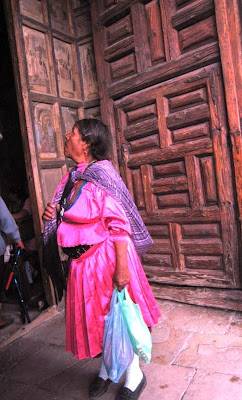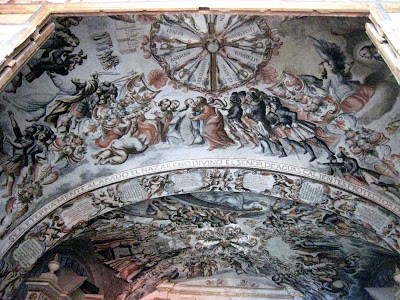
Last Sunday we thought it was the weekend for the Feria de Atotonilco, and decided to go. Our neighbors Marta, Aron and their son Ariel
We entered town from the El Cotijo side, near the entrance to La Gruta hot springs along the back side of the town. There were many cars parked along the stone fence going into town. We walked along into town. Booths began appearing, covered in colorful plastic 'lona' tarps - the Sunday market day.

Atotonilco is known for it's beautiful frescoes in the church, and this last week, along with San Miguel de Allende, Atotonilco was awarded the honor of becoming a UNESCO World Heritage Site, a great honor which will give international heritage status as well as much needed funding for restoration. Use this link to go to our tales from the road blog to see photos of the town, church and frescos.
 The ceiling, walls and doors of this church are adorned with beautiful old paintings depicting religious and Hispanic scenes. The church also attracts about two million pilgrims a year, who we were told come weekly by bus, foot or car to be locked indoors for a week to pray, flagellate themselves (really) and do penance for their sins here on earth.
The ceiling, walls and doors of this church are adorned with beautiful old paintings depicting religious and Hispanic scenes. The church also attracts about two million pilgrims a year, who we were told come weekly by bus, foot or car to be locked indoors for a week to pray, flagellate themselves (really) and do penance for their sins here on earth.
Atotonilco is locally famous for it's statue of Senor de las Columnas, depicted below as Christ leaning over an urn, with disciplinas (for flagellating) wrapped around his waist and neck, bloody and tired with three gold rays, his halo.

The statue of 'el senor' makes the annual pilgrimage of about 10 km to San Miguel de Allende, overnight, every Easter for the Semana Santa Processions, arriving two weeks before the event and enters the town on a mile long flower filled street. To see photos of this, follow this link
 Outside in the market, you'll find religious paraphernalia - disciplinas, large, small and in key chains, hand made by local artisans, and worn by all the pilgrims -
Outside in the market, you'll find religious paraphernalia - disciplinas, large, small and in key chains, hand made by local artisans, and worn by all the pilgrims - Along with Cd's that have images under resin of the Virgin of Guadalupe, Sagrado Corazon de Jesus, San Judas Tadeo to name a few - plus rosaries, gilded plastic frames with images of santos, religious cards --
Along with Cd's that have images under resin of the Virgin of Guadalupe, Sagrado Corazon de Jesus, San Judas Tadeo to name a few - plus rosaries, gilded plastic frames with images of santos, religious cards -- 
Crowns of thorns made of wood and thorny spines from the bisnaga cactus - and hand made veils made of net and flowers which the women pilgrims, young and old wear during the week of prayer. Everything you need for the passion play.
 And you can also buy an array of items for daily use -
And you can also buy an array of items for daily use -dishes, plastic goods, food, plants or a beautiful sequined purse like John is showing here.
 The food booths are selling botanas - Enchiladas, tortillas half dipped in chili salsa, fried rolled and filled with chicken and fresh cheese - gorditas, big fat tortillas rolled into a ball, cheese and chili inside, patted into a disc that is fried, then cut open and filled with meat, potatoes and corn - tacos with meat or nopales and cheese and carmelized onions. Down the way you can buy a nieve - iced milk or fruit in a variety of flavors, mango, chocolate or vanilla, zapote, limon, fresa or sandia.
The food booths are selling botanas - Enchiladas, tortillas half dipped in chili salsa, fried rolled and filled with chicken and fresh cheese - gorditas, big fat tortillas rolled into a ball, cheese and chili inside, patted into a disc that is fried, then cut open and filled with meat, potatoes and corn - tacos with meat or nopales and cheese and carmelized onions. Down the way you can buy a nieve - iced milk or fruit in a variety of flavors, mango, chocolate or vanilla, zapote, limon, fresa or sandia. Musicians wander in groups, find an area to stand or sit and play typical Mexican music with guitars and accordians.
Musicians wander in groups, find an area to stand or sit and play typical Mexican music with guitars and accordians. 
 Most of the crowd are pilgrims from ranchos and villages all over Mexico who still wear traditional clothing -
Most of the crowd are pilgrims from ranchos and villages all over Mexico who still wear traditional clothing - 
 Women in colorful satin dresses, some wearing capes with crosses sewn on them and many wearing a mixture of traditional and modern clothing and hats - all of them wearing disciplinas, ready for their week of prayer and pennance.
Women in colorful satin dresses, some wearing capes with crosses sewn on them and many wearing a mixture of traditional and modern clothing and hats - all of them wearing disciplinas, ready for their week of prayer and pennance. I have to say, that coming into town, was like going back in time to another world of people, still steeped in traditional values, clothing and reverence for god. We were unaware upon arrival, that Atotonilco, while being famous for it's beautiful church, is also a pilgrimage site for two million pilgrims per year, many of whom come from villages that still maintain traditional ways of living, and who you see here.
I have to say, that coming into town, was like going back in time to another world of people, still steeped in traditional values, clothing and reverence for god. We were unaware upon arrival, that Atotonilco, while being famous for it's beautiful church, is also a pilgrimage site for two million pilgrims per year, many of whom come from villages that still maintain traditional ways of living, and who you see here.At 5PM the pilgrims will go to the back of the church where the doors will be shut to the outside world for a week. They will be fed and basic needs taken care of while they reflect.

The windows and doors of the church are all open today, shedding light throughout. Groups take turns kneeling at the altar to cross themselves and pray. Women are crying as they pray. Tourists wander about with cameras taking pictures of the frescoes, statues and architecture. The wood floors are mosaic designs, and the wood entrance to the doorway worn down from years of footsteps passing through.

There are retablos of the stations of the cross and other religious stories painted into the doors and walls of the church and vestibules contain Santos to pray to. We were told that because of the new UNESCO World Heritage status that the market booths which surround the church in the center of town, and which have probably been a tradition for as long as the church has been standing, will no longer be allowed in front of the site after this year. The fair, which is a local event, will most likely be flooded with tourists. The status comes as a mixed blessing, bringing restoration, money and tourism to the town, but will surely change it's nature in the coming years.




1 comment:
Your photo of two women sitting is just gorgeous. Thanks for sharing!
Post a Comment